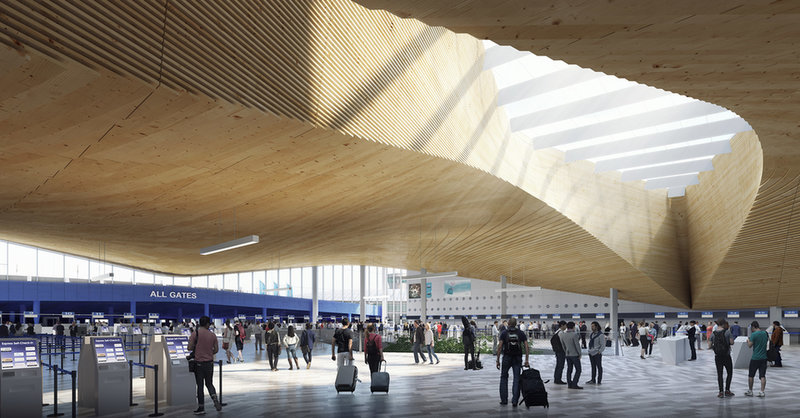Modernisation
Helsinki Airport strengthens passenger experience with technology
Finavia has invested more than €1bn in the modernisation of Helsinki Airport. Luke Christou finds out how technology upgrades will increase passenger and baggage handling capacity and improve the customer experience.
Image: copyright
Launched in 2013, Finavia’s ten-year Helsinki Airport Development Programme is now entering its final stages. With over €1bn invested, the opening of an expanded Terminal 2 next year will see terminal space jump by 45%, with baggage handling and passport control capacity to climb by 50%.
Flight capacity will also increase, with the number of bridge gates for wide-body aircraft set to double to 16, which will help to deal with Helsinki’s growing passenger numbers. While the pandemic has curtailed growth, figures for 2019 show passenger numbers had grown by more than 43% since the programme was launched.
By 2030, it is anticipated that 30 million passengers per year will pass through the airport, far surpassing the 21.9 million peak recorded in 2019.
“Even though the corona pandemic has had a significant impact on airports and travelling, we believe that investing in the development of Helsinki Airport will pay off,” says Finavia’s director of marketing, communication and customer experience, Katja Siber. “We are confident that the numbers will not only return to pre-Covid levels but continue to increase in the long run.”
As passenger numbers swell, it is hoped that the development programme will help to maintain and improve the customer experience at Helsinki. Finavia has designed the expanded terminal around its ‘four pillars of customer experience’: the gift of time, confidence, refreshing services and environment, and Finnish experience.
From easy access to public transport to touches of Finnish nature and design throughout, with ample food and beverage services, the expanded terminal has been designed to offer passengers an enjoyable airport experience in the short time they are there.

Artist illustration of the Helsinki Airport’s T2 after redevelopment.
An airport in the cloud
Technology will play a key role in keeping services accessible and transfer times short. “At Helsinki Airport, we are constantly keeping an eye on developments in technology, testing them and adapting easier and faster digital services for passengers,” Siberg explains.
As part of the programme at Helsinki and other Finavia-operated airports, the airport network operator has partnered with travel technology leader Amadeus to modernise its technology infrastructure.
Helsinki Airport will be moving to the Airport Common Use Service (ACUS) of Amadeus Flow, its integrated airport cloud solution, which enables end-to-end management for passenger services.
ACUS is Amadeus’ cloud infrastructure module that connects airports to more than 200 partner airlines over the internet, which will remove Helsinki’s 'longheld reliance on legacy network connections', according to Yannick Beunardeau, vice-president of airport IT for EMEA at Amadeus.
Moving to the cloud can drastically simplify lengthy and costly on-site systems integration projects, providing greater agility that will allow airports like Helsinki to quickly and easily adapt operations to suit changing customer needs.
“Traditionally, if an airline wants to add new IT capabilities at an airport it requires a lengthy certification cycle that sees updates released on a quarterly basis. With Flow, those constraints are removed so updates to the passenger experience can be delivered regularly and new applications easily accessed over an internet connection,” Beunardeau says.
Cloud technology helps us scale the technical infrastructure faster without large up-front investments and integration projects.
The pandemic has cast uncertainty over future passenger numbers and created an environment of rapidly changing guidelines, regulations and passenger expectations. Amadeus ACUS will make it easier for Finavia to adapt its services to changing requirements. With less effort required to maintain systems, teams have more time to anticipate changes, implement services, and create value for airport stakeholders and the passengers passing through.
“Cloud technology helps us scale the technical infrastructure faster without large up-front investments and integration projects,” explains Leyla Akgez-Laakso, Finavia’s director of information management. “It also changes the role of our internal IT, moving our time from maintaining the systems and infra towards advisory and development roles, and therefore concentrating more on the business value creation."
With Amadeus ACUS in place, airlines at Helsinki will be able to deploy new solutions in a matter of hours. Finavia is now offering its airlines Amadeus Airport Pay as an option, for instance, which enables them to accept a wide variety of payment methods at key areas, such as check-in. This will help to increase sales of add-on products such as additional legroom, while improving access to services for passengers.
Amadeus’ airport solution has enabled frictionless payments to be implemented at Helsinki through contactless technology, while ACUS will support Finavia behind the scenes by providing access to applications and tools, such as Microsoft’s productivity suite. With the potential to use a range of Amadeus solutions for arrivals, check-in, security, retail, and boarding, additional innovations are sure to follow.
“We are constantly looking into opportunities to improve our efficiency and customer experience, and we believe technologies can help us in achieving these goals,” Akgez-Laakso says.

The Luoto diorama, made of Finnish stones and greenery, will sit in the middle of the arrivals hall, offering passengers a ‘Finnish experience’.
Streamlining the airport experience
As passenger numbers dropped by 77% in 2020, the pandemic offered an opportunity for Finavia to consider the needs of its passengers, the technologies its airports will require moving forward, and how to deliver this in a cost-efficient way.
“We believe that after the pandemic, passengers will pay even more attention and desire automated solutions to support their smooth travel,” says Akgez-Laakso. “We are seeing that the way we improve how we utilise data and integrate with other stakeholders in the airport ecosystem will be key to us.”
Amadeus Flow will enable Finavia to offer a more streamlined, reliable, and automated experience for passengers at Helsinki. However, Finavia’s efforts to innovate don’t stop there.
New CT screening lines will enable passengers to carry electronic devices and liquids through security in their hand luggage.
At the new security control point for transfer passengers, a modern full-body scanner has been installed to reduce the need for manual checks and speed up the journey for passengers through the airport.
Since the start of the development programme at Helsinki, Finavia has also launched various trials of new technologies to improve the customer experience. Last year, for instance, the airport network operator began trialling the use of UVC light technology to disinfect security control trays due to the Covid-19 pandemic.
Likewise, a pilot is currently underway to test new computed tomography (CT) screening technology. If all goes to plan, CT screening lines will be implemented in the new departure hall, which is set to open to passengers in May 2022. The technology will enable passengers to carry electronic devices and liquids through security in their hand luggage without having to place them in a separate bag or container.
“We believe in trying out new technologies and finding what really makes a difference to our customer,” Akgez-Laakso says. “Some of the technologies will stick and some not, and we are planning to continue testing them in our newly developed terminal.”

The T2 departures hall. Modernisation efforts at Helsinki will focus on streamlining the passenger journey by increasing automation and reducing manual checks.
Main image: Artist illustration of the passenger drop-of point at Helsinki Airport T2. All images credit: Finavia